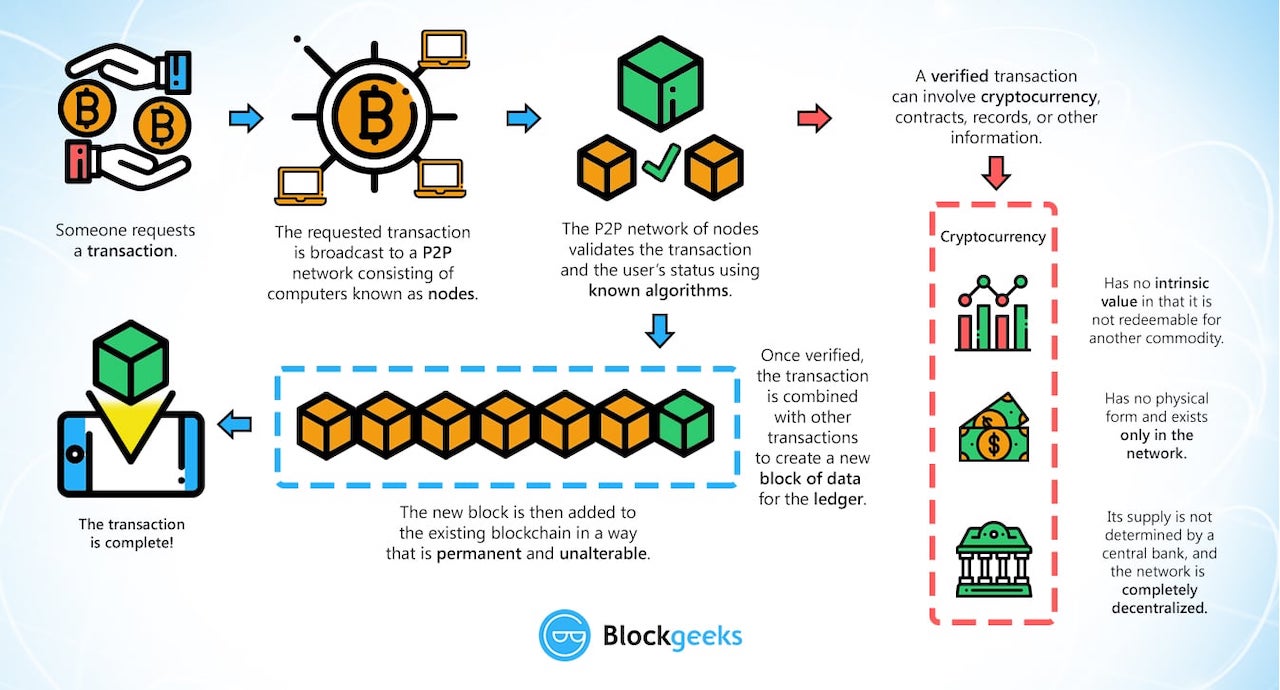Understanding Blockchain
A blockchain is, in the simplest of terms, a time-stamped series of immutable record of data that is managed by cluster of computers not owned by any single entity. Each of these blocks of data (i.e. block) are secured and bound to each other using cryptographic principles (i.e. chain).
In other words, the blockchain is a unique distributed record that stores data and verifies its integrity. By using a different set of cryptography based technologies, Blockchain assures that transaction continued into the blockchain database which is stable.
It is extremely important to undertand that - Blockchain is not limited to just currency but enlarges to any domain where anything of value is transacted, be it contracts, personal information, health records, business data and much much more.
So, what is so special about it and why are we saying that it has industry disrupting capabilities?
The blockchain network has no central authority - it is the very definition of a democratized system. Since it is a shared and immutable ledger, the information in it is open for anyone and everyone to see. Hence, anything that is built on the blockchain is by its very nature transparent and everyone involved is accountable for their actions.
A blockchain carries no transaction cost (an infrastructure cost yes, but no transaction cost). The blockchain is a simple yet ingenious way of passing information from A to B in a fully automated and safe manner. One party to a transaction initiates the process by creating a block. This block is verified by thousands, perhaps millions of computers distributed around the net. The verified block is added to a chain, which is stored across the net, creating not just a unique record, but a unique record with a unique history. Falsifying a single record would mean falsifying the entire chain in millions of instances. That is virtually impossible. Bitcoin uses this model for monetary transactions, but it can be deployed in many others ways.
Think of a railway company. We buy tickets on an app or the web. The credit card company takes a cut for processing the transaction. With blockchain, not only can the railway operator save on credit card processing fees, it can move the entire ticketing process to the blockchain. The two parties in the transaction are the railway company and the passenger. The ticket is a block, which will be added to a ticket blockchain. Just as a monetary transaction on blockchain is a unique, independently verifiable and unfalsifiable record (like Bitcoin), so can your ticket be. Incidentally, the final ticket blockchain is also a record of all transactions for, say, a certain train route, or even the entire train network, comprising every ticket ever sold, every journey ever taken.
But the key here is this: IT IS FREE. Not only can the blockchain transfer and store money, but it can also replace all processes and business models which rely on charging a small fee for a transaction. Or any other transaction between two parties.
Why Blockchain?
- It is not owned by a single entity, hence it is decentralized.
- The data is cryptographically stored inside.
- The blockchain is immutable, so no one can tamper with the data that is inside the blockchain.
- The blockchain is transparent so one can track the data if they want to.

Three Pillars of Blockchain Technology
1. Decentralization
Before Bitcoin and BitTorrent came along, we were more used to centralized services. The idea is very simple. You have a centralized entity which stored all the data and you'd have to interact solely with this entity to get whatever information you required.
Another example of a centralized system is banks. They store all your money, and the only way that you can pay someone is by going through the bank. Or just think of Google Search Engine - When you google search for something, you send a query to the server who then gets back at you with the relevant information. That is simple client-server.
In a decentralized system, the information is not stored by one single entity. In fact, everyone in the network owns the information.
In a decentralized network, if you wanted to interact with your friend then you can do so directly without going through a third party. That was the main ideology behind Bitcoins. You and only you alone are in charge of your money. You can send your money to anyone you want without having to go through a bank.
2. Transparency
One of the most interesting and misunderstood concepts in blockchain technology is "transparency". Some people say that blockchain gives you privacy while some say that it is transparent. Why do you think that happens?
Well… a person's identity is hidden via complex cryptography and represented only by their public address. So, if you were to look up a person's transaction history, you will not see "Bob shared 1 item" instead you will see "1MF1bhsFLkBzzz9vpFYEmvwT2TbyCt7NZJ shared 1 item".
So, while the person's real identity is secure, you will still see all the transactions that were done by their public address. This level of transparency has never existed before within a financial system. It adds that extra, and much needed, level of accountability which is required by some of these biggest institutions.
3. Immutability
Immutability, in the context of the blockchain, means that once something has been entered into the blockchain, it cannot be tampered with.
The reason why the blockchain gets this property is that of cryptographic hash function.
In simple terms, hashing means taking an input string of any length and giving out an output of a fixed length. In the context of cryptocurrencies like bitcoin, the transactions are taken as an input and run through a hashing algorithm (bitcoin uses SHA-256) which gives an output of a fixed length.

